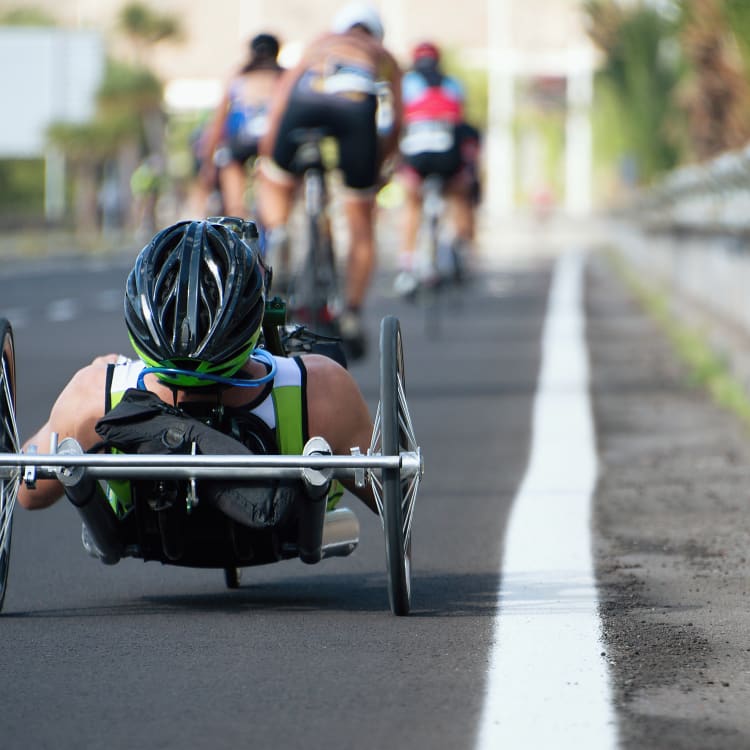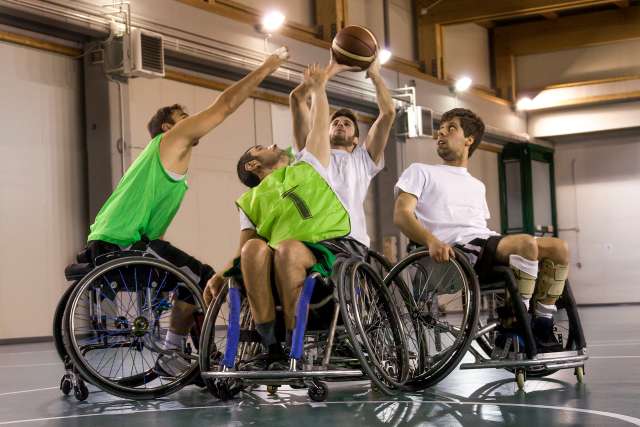
The Growth of Parasports in Japan Japan’s Wheelchair Basketball team poses for a signed photo. © Richard Miilner
Tokyo will be the first city to host the Paralympics twice. The Tokyo 2020 Paralympic Games provide a wonderful opportunity to promote awareness of the disabled community in Japan. Numerous government organizations, NGOs, groups, and initiatives have helped spread the popularity of parasports in recent years. Interactive events, competitions, and new training facilities provide fans and athletes with the chance to interact and promote parasports, while also helping to enhance the athletic skills of the para-athletes involved.
The 6 million disabled individuals in Japan face challenges every day that many non-disabled people take for granted: getting on a train, going to a bar, or just making it up to the second floor of a department store. Increasingly, many Japanese have decided to tackle their disability through sports.
Parasports (a combination of the Greek preposition “para” (beside or alongside) and the word “sports”) refers to sports enjoyed by individuals with various disabilities. Most often this includes mobility disabilities such as being wheelchair-bound (e.g., archery, rugby, tennis), visually impaired (e.g., goalball, judo, rowing), or those who have some kind of intellectual disability (e.g., table tennis, swimming, dressage). In Japan those with disabilities can enjoy parasports on a casual level, or become professionally involved in one league or another.
The Japanese Para-Sports Foundation, founded in 1965, is the governing body overseeing parasports in Japan. In conjunction with the Japan Sports Association (JSPO) and Japanese Olympic Committee (JOC), they have worked hard to increase awareness of parasports in Japan, and enhance its professionalism and expand the search for national talent. Numerous outside groups, NGOs, and initiatives have joined the effort. The hedge fund WisdomTree has lent financial backing, while the Tokyo Diversity Lab develops interactive experiences for non-disabled people to simulate the experiences of the disabled.
The Tokyo Paralympics, in particular, provide an excellent opportunity for engaging with the public, increasing general interest in parasports, and helping to develop a more inclusive environment within Japan for those with disabilities. Parasports can be the bridge between disabled and non-disabled individuals, and inspire confidence in a new generation of disabled people.
PARASPORTS IN JAPAN
Even though parasports may be the bridge between the disabled and non-disabled, there are still challenges. About one-third of parasports leagues are not legally incorporated, have no dedicated offices, and are essentially voluntary for the staff involved. This makes it difficult to train athletes to an Olympic-level standard, and harms the legitimacy of the parasports community.
However, organizations such as The Nippon Foundation Paralympic Support Center stand at the forefront of the movement in Japan to create a society where the disabled and the non-disabled co-exist. CEO Nao Ozawa, emphasizes that the purpose of the center is not only to provide support for Paralympic national sports federations, but to help eliminate all barriers that separate disabled and non-disabled people. Mr. Ozawa believes acceptance of many different types of people, the disabled included, is key to the progress of not only Japanese society, but the greater global society. Ideally, the center shouldn’t need to exist, at all.
Since its founding five years ago, the Nippon Foundation Paralympic Support Center has made great strides to help advance the rights and lives of the disabled. They host over 1000 programs a year, such as Asuchalle ! School, where para-athletes visit schools and demonstrate their sports directly. Auschalle ! Sports Day is an interactive sporting event for participants typically from corporate settings. Parasports Messenger features lectures in professional environments given by para-athletes certified as public speakers.
The center currently employs 30 people in its fully barrier-free office space, which has low-positioned door handles and copiers for those in wheelchairs, as well as color-coded inclines and wide lanes for ample travel space. The office also contains signage in braille. Impressively, the center has dedicated desks and facilities for each of the 29 Paralympic national sports federations, and even offers accounting and legal support for these groups. In a symbolic choice, the office has an open floor plan, with as few dividers between people as possible.
Mr. Ozawa also spoke about barrier-related changes that have happened within Tokyo. For instance, public transportation and taxis now generally grant access to those in wheelchairs. To help in this endeavor, Canadian-born, Tokyo resident Josh Grisdale operates a site called Accessible Japan, which even has an app that shows wheelchair-accessible toilets throughout Tokyo.
Changes in attitude have bubbled up to the governmental level, as well. Legislations like 2013’s Act on the Elimination of Discrimination against Persons with Disabilities, help tackle barrier-free access across the board.
PUBLIC INVOLVEMENT
Much of the recent public involvement with parasports has come from organizations pushing for inclusivity, and awareness of the everyday challenges faced by those with physical and mental disabilities.
On the promotional front, the Nippon Foundation Paralympic Support Center has garnered the support of celebrities such as talent Shingo Katori to help the cause. Katori hand-painted a mural on the wall of the center’s office, and proceeds from public viewings of the mural were used to develop a Find My Parasport app. The app allows users to explore which parasport is best for them to practice.
Celebrities such as beloved comedian Naomi Watanabe, who fits perfectly with the center’s stated goal of erasing barriers and bringing people together, have taken to social media of their own accord to show their support of para-athletes. Watanabe was featured in Parasapo Magazine, Volume 3, where she spoke with Wheelchair Rugby’s first female team member, Kae Kurahashi. Famed photographer Mika Ninagawa has also gotten involved by taking stylized, gorgeous photographs of parasports athletes for the free magazine GO Journal.
These kinds of efforts have proven invaluable in gaining the public's attention towards parasports and the lives of the disabled. They add a personal touch and connect people to issues they might not otherwise know about.
Lives Tokyo was another excellent example of an event that promotes both disability awareness and engagement with parasports. One highlight was talk by Tomohito Yoshino, described as “Japan’s first para-esports athlete” (para-esports offers barrier-free e-sports opportunities to players). Attendees can also try on prosthetic limbs and participate in games and simulations meant to confer a sense of greater understanding. The organizer of Lives Tokyo, and chairman of the volunteer group Hands On Tokyo Theodore Guild, stated in 2018 that he wanted to, “make sure people with disabilities enjoy the same human rights as the rest of society.”
The Japanese Broadcasting Corporation (NHK) also promotes parasports, and the Paralympic Games in particular, through a series of YouTube animation shorts with the sub-heading “Who is Your Hero?” featuring mini-narratives about fictional parasports athletes.
As far as popularity of specific parasports is concerned, Mr. Ozawa says that Wheelchair Basketball is easily the most recognizable parasport among non-disabled individuals. It’s fast, fun to watch, and easily understood by the public because of its similarities to traditional basketball. Additional efforts are underway to try and boost the appeal of other, lesser known sports such as Paralympic rowing, which only 0.8% of Tokyo residents were familiar with according to a recent survey.
To that end, and to boost attendance of the Paralympic Games, the Tokyo Organizing Committee of the Olympic and Paralympic Games was considering strategies to create “full stadium” sellouts during the games, such as lowering prices for children, the elderly, and the disabled. In the original plan, over 1,000,000 seats had also been pre-allocated for children ranging from elementary school to high school.
Hopefully, the efforts on behalf of numerous organizations to gain the attention of the public and increase engagement to develop the momentum necessary to propel both the Paralympics and disability awareness to new heights.
THE PARASPORTING COMMUNITY

In order to give para-athletes proper training facilities, the Nippon Foundation Paralympic Support Center opened a dedicated disabled person’s athletic facility in 2018 on the grounds of the Museum of Maritime Science in Tokyo Harbor. According to Mr. Ozawa, this facility, the Nippon Foundation Para Arena, has a 100% usage rate. This is one key way that para-athletes can not only train, but gain a stronger sense of community with fellow athletes.
Another Paraspo project focused on bringing athletes together is a parasports festival dubbed “Field Day.” Athletes can participate in a variety of sports to see exactly how fun and rewarding they can be.
THE FUTURE OF PARASPORTS
The future of parasports is bright in Japan. The Japanese public seeing individuals with disabilities performing at such a high level during the Paralympic Games, may go a long way towards dispelling stereotypes about the capabilities of those who are not able-bodied. Gold medals aren’t even necessary; merely the confidence and strength of the athletes involved.
The Paralympic Games can also invigorate the progress of professional and amateur parasports in Japan. Training facilities, talent scouting, and regular tournaments can help draw fans to parasports, and increase competitiveness and skill amongst athletes. Public events such as those held by the Nippon Foundation Paralympic Support Center can help promote awareness and acceptance of diversity. So be sure to include parasporting events in your visit to Tokyo for the next Olympic Games, and Paralympic games.
USA
Resident of Japan for over 5 years. Lived in Nagoya, Sendai, and Tokyo.
I am a writer, teacher, and speaker currently working and living in Tokyo. I have an MA in Digital Creative Media and a BA in Psychology, and I have worked as a narrative designer in the video game industry and also as a mental health care professional in New York. In my spare time I love to travel, read, and practice yoga.




























































